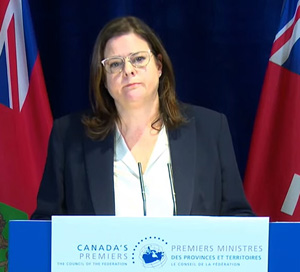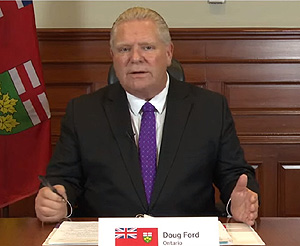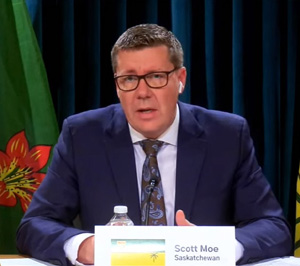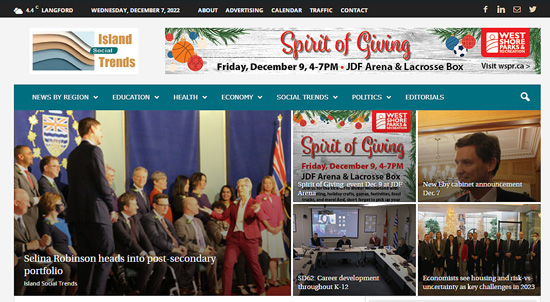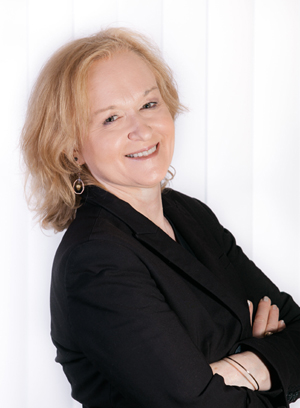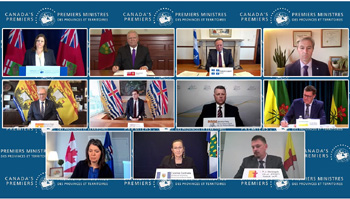
Friday December 9, 2022 | NATIONAL (from VICTORIA, BC) | Updated 12 noon Pacific Time
Editorial by Mary P Brooke, B.Sc., Editor | Island Social Trends
The 13 provincial and territorial premiers are continuing to butt heads with the federal government over their request for an increase in the Canada Health Transfer (CHT).
Today in a virtual press conference as the Council of the Federation (COF), the premiers — led by COF Chair Heather Stefanson — repeated their statement that they need a significant boost to the CHT, without conditions from the federal government as to how those funds would be spent, i.e. no strings attached.
At their meeting in July 2022 in Victoria the Premiers made the same pitch. Same thing at a meeting of provincial health ministers, held in Vancouver last month.
Hearing the premiers asking for 2.5 years and (as they oft repeat) with the desire to ‘not negotiate through the media’, sounds a bit by-rote now. Almost with a tantrum-like approach. And they *are* doing it through the media. It’s causing the public to tune out, and strikes the media as a bit repetitive and has journalists chasing around for new angles and reasons to keep this as a top news coverage priority when the political directions are not really anything fresh.
The premiers are looking for a substantial boost in the CHT from 22% to 35%. Many years ago when the CHT was established, the split was 50/50.
Falling flat:
Using the blunt repetitive approach to ask for a meeting with Prime Minister Justin Trudeau to discuss the CHT increase is now falling flat.
Though it does continue to be notable that premiers across the political spectrum are banding together on this issue.
But for such a range and scope of political talent at the COF table to be pounding away for one thing — for a meeting, as they say “already promised” — means either there is a collaborative (federal and provincial) political game of timing in the works behind the scenes and/or the premiers simply aren’t listening (or amply responding) to what Trudeau has been saying for over a year: he is willing to meet with the premiers but wants evidence of where progress would be made with increased funding.
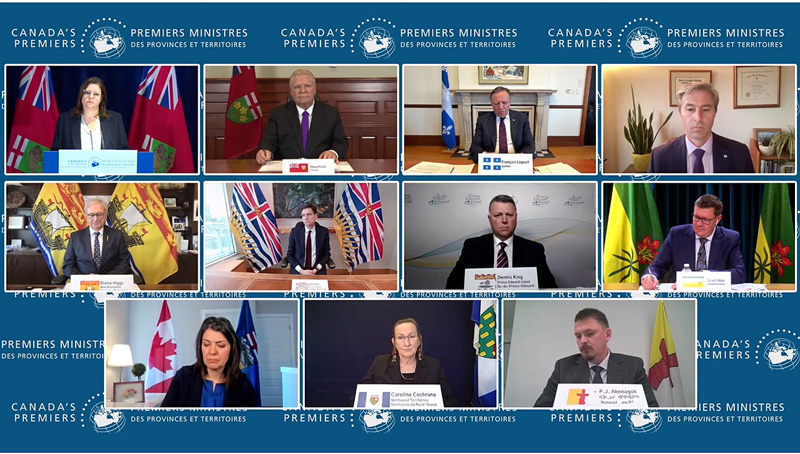
Over the past year, Trudeau has given clues as to what he and his government are looking for, such as nodding to the BC government’s improvement of mental health and addiction treatment beds along with wrap-around supports, as that province’s effort to improve service delivery. BC has also just announced a new medical school, expected to bring more doctors into training by September 2026.
When the COVID-19 pandemic hit, the federal government contributed substantial funds toward the supply of personal protective equipment (PPE) to the provinces as well as procuring and reliably supplying and distributing vaccines across the country.
Step-by-step as an option:
Would an approach of accepting step-by-step federal funding as crises and challenges come up perhaps be a more attentive and nuanced approach, instead of persisting about having a meeting together in Ottawa?
If the federal government were to provide funding now — in the case of pediatric hospitals needing support — upon the condition of provinces delivering specific long-term system improvements (e.g. more specially trained workers, more specific equipment, or an improved data system), how would that not serve Canadians across the country?
That would still give provinces and territories the flexibility to determine how they can best use the incoming funds for the current crisis, in ways that respond best to their situation at that juncture of health-care demand.
That would of course seem like a signal from the provinces that they are ‘bowing’ to federal pressure and direction, but if truly the goal is to improve health care, perhaps it’s time for less political gamesmanship and more management-type assessment of health care system need coupled with political direction from premiers as to supporting the people in their provinces with authentic responses to the health care crisis.
To start taking that approach, it might seem like one step at a time, and perhaps even seem like a weak political stance with the prime minister. But it would show fortitude by premiers to their respective provincial and territorial populations which would serve premiers well at the polls in their next round of provincial elections.
And in the meantime, real improvements in health care would be laid down, step by step, as a new forward-looking foundation.
Stefanson as COF Chair:
Stefanson took the lead, as COF Chair, answering most of today’s media questions. She became chair after the July 2022 COF meeting chaired by then BC Premier John Horgan in Victoria, where the theme of asking for a meeting with the prime minister was the same theme.
Quebec Premier François Legault answered questions for the French media. Also addressing media were Ontario Premier Doug Ford, Saskatchewan Premier Scott Moe, Nova Scotia Premier Tim Houston, and Alberta Premier Danielle Smith.
Legault outlined that Quebec has made improvements or investments in human resources, information technology, data systems, and infrastructure.
BC Premier David Eby was not asked any direct media questions today, even though his province has arguably made significant strides in health care delivery (in certain respects).
Federal response:
Federal Health Minister Jean-Yves Duclos today said afterward that once “results are agreed upon”, then the federal government can “talk about dollars”. He said that if it was just about money, the health care problems would have already been solved.
===== RELATED:
New BC Cabinet announced by Premier David Eby on Dec 7 (December 7, 2022)
Economists see housing and risk-vs-uncertainty as key challenges in 2023 (December 6, 2022)
First new medical school in western Canada in over 50 years (November 28, 2022)
Canada’s premiers: priorities for economic recovery & health care (July 13, 2022)
Day 2 in Victoria: Premiers hone in on health care priorities (July 12, 2022)
Day 1 in Victoria: Premiers discuss health care funding (July 11, 2022)
===== ABOUT ISLAND SOCIAL TRENDS:
Island Social Trends is a professional news portal at islandsocialtrends.ca .
Fully online since mid-2020, Island Social Trends emerged from the extensive groundwork of previous print publications in the west shore: MapleLine Magazine (2008-2010), Sooke Voice News (2011-2013), and West Shore Voice News (2014-2020).
Since 2008, journalist and editor Mary P Brooke has spearheaded all those publications, taking an analytical socioeconomic lens to the news of the Greater Victoria west shore and south Vancouver Island region, including BC provincial news, and national news impacts.
Ms Brooke’s career in journalism, curriculum and publishing goes back to the 1980s. She is also a career-long entrepreneur (including real estate, online training, retail, and publishing). She holds a B.Sc. in nutrition and community health education, a university certificate in Public Relations, and a specialized certificate in digital marketing.



